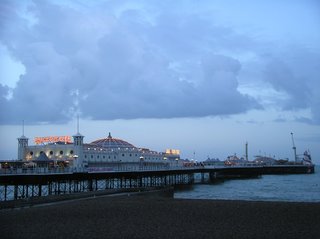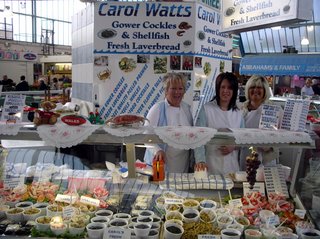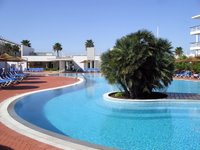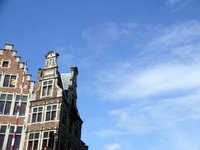There comes a point late into a Danish wedding party when word goes round that it's time to cut the end off the groom's sock.
Now, with Gloria Gaynor pumping away in the background and several glasses of øl already dispatched, that sounds like the sort of drunken idea that is just one misheard consonant away from putting a serious dampener on the wedding night.
The Danes, however seemed well prepared. The hapless chap was duly yanked off his feet, relieved of his patent leather shoes before a flash of scissors leaves five bare toes poking out from his truncated hose.
"It's to make him unattractive to other women," explains the suitablely beautiful blond bride. "In the old days, women wouldn't look at man with a hole in his socks."
So logical enough then.
With hopes of sowing wild oats thus ruled out, the groom can only be grateful for that other local tradition which states that whenever the bride nips out to powder her nose, all the females in the room must rush over to give him a kiss.
Fortunately Scandinavian equality ensures that the chaps all get to snog the bride each time the sockless one pops out for a Carlsberg-induced pee.
 These particular Nordic nuptials could hardly have had a more spectacular setting. Middelgrundsfortet is one of three sea fort builts in the Øresund strait between Copenhagen and the Swedish coast toward the end of the 19th century, persumably to head off any threat of attack by maurading Swedes.
These particular Nordic nuptials could hardly have had a more spectacular setting. Middelgrundsfortet is one of three sea fort builts in the Øresund strait between Copenhagen and the Swedish coast toward the end of the 19th century, persumably to head off any threat of attack by maurading Swedes.
On a long midsummer's evening, bathed in gentle sunlight the view from here sweeps round from the Swedish shore past the delicate 8 kilometre curve of the Øresund bridge which now connects the two countries, to the church spires that punctuate Copenhagen's skyline.
Middelgrundsfortet is the world's largest artificial island but a stroll round its grassy perimeter takes only about five minutes.
Although some (disarmed) anti-aircraft missiles are still on show to remind visitors that this was a military base up to the 1980s, the island is now a popular day-trip or weekend destination for Copenhagers. Within the labyrinth of bunkers built into it is one of the city's strangest hotels.
Guests reach their rooms along long echoing underground corridors. It's all a bit Alcatraz, but beyond the heavy iron doors, the rooms are spacious, decorated with nautical charts and have the air of an seacaptain's cabin. Ours had a splendid view over the sound and Copenhagen in the distance.  The island has small beach for those brave enough to face the chill, and a fine terrace along the quay side with cafes and a restaurant. Our wedding feast was held in a long candlelit mess room, all very hygge (cozy - a suprisingly important concept in this land of minimalist design). The menu reflected the long-standing French influence over the way Danes treat their abundant northern fisheries and renowned agricultural produce.
The island has small beach for those brave enough to face the chill, and a fine terrace along the quay side with cafes and a restaurant. Our wedding feast was held in a long candlelit mess room, all very hygge (cozy - a suprisingly important concept in this land of minimalist design). The menu reflected the long-standing French influence over the way Danes treat their abundant northern fisheries and renowned agricultural produce.
Turbot and langoustine were moulded into a terrine with typical Nordic herbs chervil and dill, this was followed with veal stuffed with breast of guinea fowl and foie gras, flavoured with truffle oil. Then Gateau Marcel - a favourite Danish chocolate cake - served with a rum and white chocolate mouse, and carrot and orange sorbet.
Danish food is not always so fancy.
It's still possible to get red polser hot dogs from stalls around the city, or pick up soused herring and smoke eels from the harbour side in the pretty fishing harbour of Dragør.
Visiting a few years back a Danish friend answered my request for typical local food by taking us to a basement restaurant just off the Strøget _ the shopping street that runs through the heart of the city. I tried the hakkebøf med kartofler, bløde løg og spejlæg _ which is basically a beefburger with potatoes, onions and fried egg.
Next night we were down in one of the old taverns of Nyhavn, once an infamous seafarers haunt, now surely one of Europe's most beautiful city streets, a harbour inlet filled with old boats and lined on each side by candy-coloured merchants' houses. 
This time, my friend suggested I try biksemad. Which turned out to be basically minced beef with potatoes, onions and fried egg. When I pointed out that this seemed to be somewhat similar to last night's delicacy, Jan was amazed. "No, no, this is completely different, the meat here isn't formed into a burger, AND this has slices of beetroot!"
I forgave him, largely because he also took me on a bar crawl that took in Charlie's, a crowded little dive on the Pilestræde where dedicated drinkers down wonderful local ale's like Fuglsang and Hancock with a slighly furtive air, as if the Carlsberg/Tuborg beer police might somehow catch the breaking the big brewery's stranglehold.
He also led me to trendy place nearby where a beautiful, if slightly inebriated, blond, started out of the blue to nibble on my neck. Jan dragged me away. "I'm really sorry," he said, before I could protest. "That happens all the time up here."
Danes do like to have fun. During the long summer nights the cafe terraces and historic sailors' pubs that line Nyhavn are jammed with revellers and next morning, those who overdid it with the øl and aquavit can be found sprawled on the cobbles. At the other end of the Strøget _ Europe's longest pedestrian street _ is the Tivoli amusement park a sprawling collection of scary rides, open air restaurants and lantern-lit gardens which has captivated kids and their parents since the days of Hans Christian Andersen.
Of course, Copenhagen is also a capital of cool, renowned for its stark design of B&O stereos, Bodum teapots and the functional furniture of Arne Jacobsen. To be surrounded by some of this white-on-white modernism, try The Square hotel, just down the street from Tivoli on Rådhuspladsen. It offers a bargain "therapy for couples" stay for just 1,000 kroner that includes a free bottle of champagne and a Danish pastry (here they call it Wienerbrod) laden buffet breakfast from the top floor restaurant overlooking town hall square.
The Langelinie Pavillonen down by the quay near the Little Mermaid is a chance to eat among some of that Danish design. A 1950's glass square offering great views across the harbour and filled with Jacobsen's "ant" chairs and Poul Henningsen's artichoke lamps, this place was so cool that Wallpaper magazine chose to have its Copenhagen reception there. The food is a fine Franco-Danish combination and there are dance halls, lounges, sun terraces for chillin'. However, it's best to call ahead, (+45 33 12 12 14) because the place is often booked up for parties or corporate functions.
Another sophisticated eatery is the unlikely named Cafe Ketchup in the heart of downtown. This has a cool cafe at street level and a grown-up restaurant in the basement where prime local ingredients are given a gourmet makeover into the likes of baked cod served with pan fried and smoked roe and a warm salad of chanterelles, baby spinach and baked balsamic beetroot or grilled beef tenderloin on potato/celery purè flavoured with truffle, sautéed mushrooms and cranberries.
There's a fabulous wine list, and if you're in a group ask for your own room under the stairs. All this does not come cheap, but it's great for a blow out and they've recently opened a second restaurant in the Tivoli.
Ketchup proudly announces the North Sea or Baltic origin of its fish. That's not always the case.
The Mühlhausen Brasserie is a pleasant enough place on HC Andersens Boulevard with an interesting selection of modern art work and a reputation for grilled lobster, but when we asked the waitress where it was from _ fully expecting her to say it was plucked from the Kattegat fresh that morning _ she said "Egypt." Oh well, it was tasty enough, among the eclectic variety of vegetables served with it was a hummus-like chickpea puree, perhaps in homage to the Middle Eastern origins of the crustaceans. We started with sea scallop carpaccio with truffle oil, but didn't like to ask were they were from. The fruity Albarino wine was definitely from Galicia.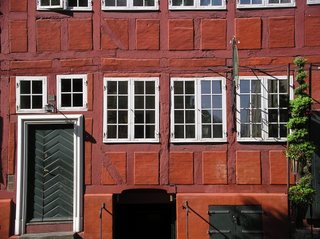 The long June days can transform Andersen's city from a drab, winter duckling into glittering summer swan overlooked by vast skies of forget-me-not blue where the sun rises at 4 a.m. and slips away just before midnight after longest, lingering dusk.
The long June days can transform Andersen's city from a drab, winter duckling into glittering summer swan overlooked by vast skies of forget-me-not blue where the sun rises at 4 a.m. and slips away just before midnight after longest, lingering dusk.
It makes Copenhagen a great town for walking in. Much of centre is traffic free, although you do have to watch out for the powerful looking women on big black bikes who seem to thunder by from all directions.
The Strøget is the main axis running through the old town getting more upmarket the closer you get to the Kongens Nytorv the great square with its temples of belle époque class - the Hotel d'Angleterre, royal theatre and the Magasin du Nord _ this being Copenhagen's chicest department store, with a basement foodhall which is a great place to pick up Danish delicacies from Albani beers to danablu cheese.
The Royal Copenhagen Porcelain Manufactory, Bodum homeware and the Illums Bolighus design shop are also to be found along Strøget. The street, which actually changes its official name several times along its length, cuts though several elegant squares including Amagertorv, where the Cafe Europa provides a strategic spot from where to watch the world go.
Wander off the main drag and Copenhagen is full of intriguing backstreets lined with little shops selling antiques, perfumed candles, second-hand books. The wonderful charts found in fishmongers around the world with drawings showing fish species in a dozen languages are made in Denmark and can be picked up in bookstores here. The dead trendy make-it-yourself IQL lamps are sold in the Bald & Bang Shop in Rømersgade.
There are cobbled streets lined with the high facades of bourgeois homes painted in rainbow shades, courtyards where the dappled sunlight pics out half timbered houses in vivid red or shocking orange.
Rosenborg Slot is a fairytale castle in peaceful parkland. Built in the early 17th century by it was once the home of the royal family and still contains the Danish crown jewels. A tour through it is a great introduction to the country's history. Rose Tremain's novel "Music and Silence" set in the renaissance court of King Christian IV would make the perfect accompaniment to a visit.
Today the royal residence is down the road in the Ameliaborg castle where guards in bearskins and sombre blue coats protect the neoclassical castle and steadfastly refuse to smile despite the best efforts of camera-snapping Japanese tourists. 
Further afield is the Opera house which opened in 2005 to the complaints of traditionalists objecting to its great square roof jutting out across the harbour towards the royal palace and the Little Mermaid. Soon to join it is an ultramodern ballet centre next to Nyhavn. Heading the other way down the waterfront is the "black diamond," a futuristic glass library.
The Ny Carlsberg Glyptotek, just next to the Tivoli, contains the city's best art collection displayed in airy galleries, amid tropical plants. It has Egyptian mummies, northern Europe's best collection of Greek and Roman art, Rodins, Degas' and Gauguins, plus the airy landscapes of home-grown painters from Denmark's 'golden age" in the early 19th century.
Better known Danish art works are served for lunch. Smørrebrød is the country's most renowned gastronomic invention and the words open sandwich just doesn't do it justice. A spread of these delicate little arrangements of cheese or meat or fish matched up with slices of rye or white bread is designed to combine colours, textures and flavours in a feast for the eyes as well as the palate.
Ida Davidsen is Copenhagen's most famous purveyor of smørrebrød. Her family has been serving their complex snacks to Copenhagen for three generations and her little restaurant on Store Kongensgade is often besieged with customers keen to try her latest innovations which she tends to name after various great Danes.
Footballer Michael Laudrup is honoured with a concoction of roast pork, tomato and beetroot, while jazzman Victor Borge gives his name to layers of raw salmon, lumpfish caviar, Greenland shrimps and crayfish tails served with lime and dill mayonnaise.
The choice can seem baffling.
At a family lunch we served Gravlaks med raevesauce _ marinated salmon with mustard sauce; dyrlaegens natmat _ the vet's midnight snack featuring salt meat and liver paste served with raw onion rings; roget aal og roraeg _ smoked eel with scrambled egg; rejesalat _ prawn salad; and one whose name escaped me that involved duck with red salad.
Normally these are despatched with beer and ice-cold aquavit, but our hosts were among those many Danish francophiles and served a wonderful sancerre that matched a treat. Skal! Practical
Practical
We flew to Copenhagen with SAS -- fro 168 euro return inc. taxes.
Bed and breakfast at The Square was 1,000 DKK (about 135 euro) with a bottle of champers thrown in under the Couple Therapy plan.
A night in the.Middelgrundsforte was also 1,000 DKK inc. breakfast.
Dinner:
Main course at Cafe Ketchup around 280 DKK
At Langelinie Pavillonen around 225 DKK
At Mühlhausen Brasserie around 175 DKK
Ida Davidsens smørrebrød also available to takeaway run from 50 DKK to 150 DKK.
Reading
Rose Tremain's novel "Music and Silence" is set in the renaissance court of King Christian IV.
Karen Blixen's "Winter Tales" are good for Nordic atmospherics.
Jens Christian Grøndahl's "Silence in October" is a tale of angst ridden love armong the arty set in modern Copenhagen.

